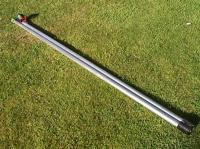The MassTech tank measurement service measures the tank diameter, length and orientation of an in-situ underground tank without emptying it, provided there is a vertical access of 50mm diameter from the surface to the tank floor.
The MassTech tank calibration service takes existing reconciliation records and from them calculates the shape and size of tank that best fits the data. The client receives the new strapping table back as an xls file that can then be further improved at no extra cost and for no further investment.
Required information
Recalibration from reconciliation records requires:
- Enough days of data - 35 as a minimum.
- Each tank to be separately accounted.
- No event to occur which could change the fundamental basis.
- Deliveries to be assumed accurate.
- The basis of the dip readings to be known, normally a strapping table or ‘heights’ on a dip rod – see below.
- All deliveries to be accurately recorded.
- Dips to be taken daily after sales have finished for a period or before they have started.
NB Occasional errors in sales or dip readings can be tolerated but averaging three dips overcomes most issues.
Options if no strapping table information is available
Where the client has no information about the capacity or shape of the tank, there are a number of possibilities:
- From the nominal capacity and diameter, MassTech can produce a strapping table.
- From either level measurements against daily sales, MassTech can produce a strapping table - the so-called decremental fill method.
- From height measurements before and after a significant delivery, MassTech can produce a strapping table - the so-called incremental fill method.
- MassTech can measure an insitu tank for you, using an available vertical aperture of at least 50 mm.
The measurement process
The technician normally accesses the tank via the direct fill, a dip point, an available tapping on the tank lid or via the ACV in the product line. The last option requires the line to be drained back during measurement. The tank may be in any fill condition and with virtually any liquid, though for chemicals, specific advice needs to be provided.
The measurement device is intrinsically safe and can therefore be used in the hazardous zone. The measurement process on site usually takes about 10 minutes and then this data is evaluated in one of MassTech’s analysis centres and a strapping table of the tank is provided.
Improvements in accuracy can be obtained from subsequent reconciliation records using the MassTech Recalibration System.
Features of the output from the MassTech Measurement & Calibration Service
The main output from the system is a strapping table that represents inventory in litres against fuel level in mm through the entire tank diameter. To keep the strapping table to a single page, increments of 5mm are chosen with amounts to add per mm at the foot of each column to cover steps between increments. In addition the system will:
- Provide the actual capacity, length and diameter of the tank (note that the safe working capacity should be taken as being 95% to 97% of the actual capacity).
- Provide the position of the tank ends relative to the measurement position and the compass direction of the tank, thus allowing the ‘corners’ of the tank to be marked on the forecourt.
- Provide a true apparent loss or gain figure.
- Retrospectively correct any earlier reconciliation record based on the same strapping table.










